- Home
- Medical news & Guidelines
- Anesthesiology
- Cardiology and CTVS
- Critical Care
- Dentistry
- Dermatology
- Diabetes and Endocrinology
- ENT
- Gastroenterology
- Medicine
- Nephrology
- Neurology
- Obstretics-Gynaecology
- Oncology
- Ophthalmology
- Orthopaedics
- Pediatrics-Neonatology
- Psychiatry
- Pulmonology
- Radiology
- Surgery
- Urology
- Laboratory Medicine
- Diet
- Nursing
- Paramedical
- Physiotherapy
- Health news
- Fact Check
- Bone Health Fact Check
- Brain Health Fact Check
- Cancer Related Fact Check
- Child Care Fact Check
- Dental and oral health fact check
- Diabetes and metabolic health fact check
- Diet and Nutrition Fact Check
- Eye and ENT Care Fact Check
- Fitness fact check
- Gut health fact check
- Heart health fact check
- Kidney health fact check
- Medical education fact check
- Men's health fact check
- Respiratory fact check
- Skin and hair care fact check
- Vaccine and Immunization fact check
- Women's health fact check
- AYUSH
- State News
- Andaman and Nicobar Islands
- Andhra Pradesh
- Arunachal Pradesh
- Assam
- Bihar
- Chandigarh
- Chattisgarh
- Dadra and Nagar Haveli
- Daman and Diu
- Delhi
- Goa
- Gujarat
- Haryana
- Himachal Pradesh
- Jammu & Kashmir
- Jharkhand
- Karnataka
- Kerala
- Ladakh
- Lakshadweep
- Madhya Pradesh
- Maharashtra
- Manipur
- Meghalaya
- Mizoram
- Nagaland
- Odisha
- Puducherry
- Punjab
- Rajasthan
- Sikkim
- Tamil Nadu
- Telangana
- Tripura
- Uttar Pradesh
- Uttrakhand
- West Bengal
- Medical Education
- Industry
High-sensitivity CRP and monocyte to HDL ratio associated with Increased Type 2 Diabetes Risk: BMC study

A recent study published in the Journal of Translational Medicine explored the intricate relationship between monocytic inflammation, C-reactive protein (CRP) and the onset of type 2 diabetes (T2D). The investigation looked into the association between systemic inflammation that assessed by joint cumulative high-sensitivity C-reactive protein (CumCRP), monocyte to high-density lipoprotein ratio (CumMHR)and the incidence of T2D within the general population.
Over 40,000 nondiabetic individuals participated in this prospective real-life cohort study, with biennial follow-ups that spanned from 2010/2011 to December 31, 2020. Through rigorous multivariable Cox regression analyses, the team evaluated adjusted hazard ratios (aHRs) of incident diabetes.
The findings revealed that over a median follow-up of nearly eight years, 4848 cases of T2D emerged. CumMHR and CumCRP was found to be significant predictors of T2D, both independently and in conjunction. The elevated CumMHR levels were found to increase the risk of developing diabetes across all CumCRP strata by indicating a relationship between these markers. The observation that individuals with concurrent elevations in CumMHR and CumCRP underwent the highest risk of T2D by emphasizing the importance of considering multiple markers in assessing diabetes risk was striking.
This study highlighted the influence of demographic and clinical factors such as age, sex, hypertension, dyslipidemia and prediabetes status on the observed risk. This precise understanding underlines the complexity of T2D development and the need for personalized risk assessment strategies. The addition of CumMHR and CumCRP to established risk factors significantly enhanced risk prediction and reclassification of diabetes by improvements in C-statistics and net reclassification improvement.
Reference:
Wu, D., Chen, G., Lan, Y., Chen, S., Ding, X., Wei, C., Balmer, L., Wang, W., Wu, S., & Xu, W. (2024). Measurement of cumulative high-sensitivity C-reactive protein and monocyte to high-density lipoprotein ratio in the risk prediction of type 2 diabetes: a prospective cohort study. In Journal of Translational Medicine (Vol. 22, Issue 1). Springer Science and Business Media LLC. https://doi.org/10.1186/s12967-024-04895-4
Neuroscience Masters graduate
Jacinthlyn Sylvia, a Neuroscience Master's graduate from Chennai has worked extensively in deciphering the neurobiology of cognition and motor control in aging. She also has spread-out exposure to Neurosurgery from her Bachelor’s. She is currently involved in active Neuro-Oncology research. She is an upcoming neuroscientist with a fiery passion for writing. Her news cover at Medical Dialogues feature recent discoveries and updates from the healthcare and biomedical research fields. She can be reached at editorial@medicaldialogues.in
Dr Kamal Kant Kohli-MBBS, DTCD- a chest specialist with more than 30 years of practice and a flair for writing clinical articles, Dr Kamal Kant Kohli joined Medical Dialogues as a Chief Editor of Medical News. Besides writing articles, as an editor, he proofreads and verifies all the medical content published on Medical Dialogues including those coming from journals, studies,medical conferences,guidelines etc. Email: drkohli@medicaldialogues.in. Contact no. 011-43720751


